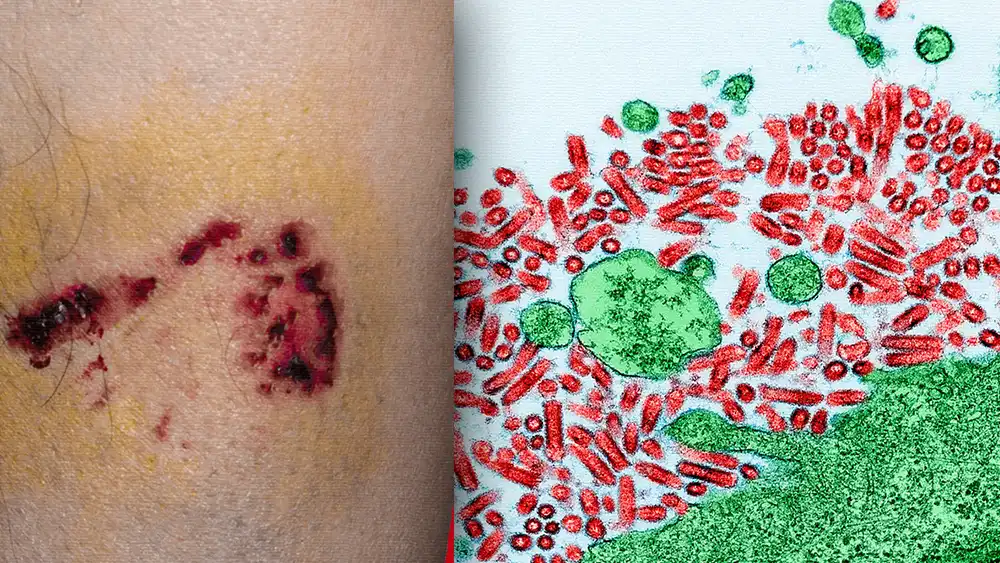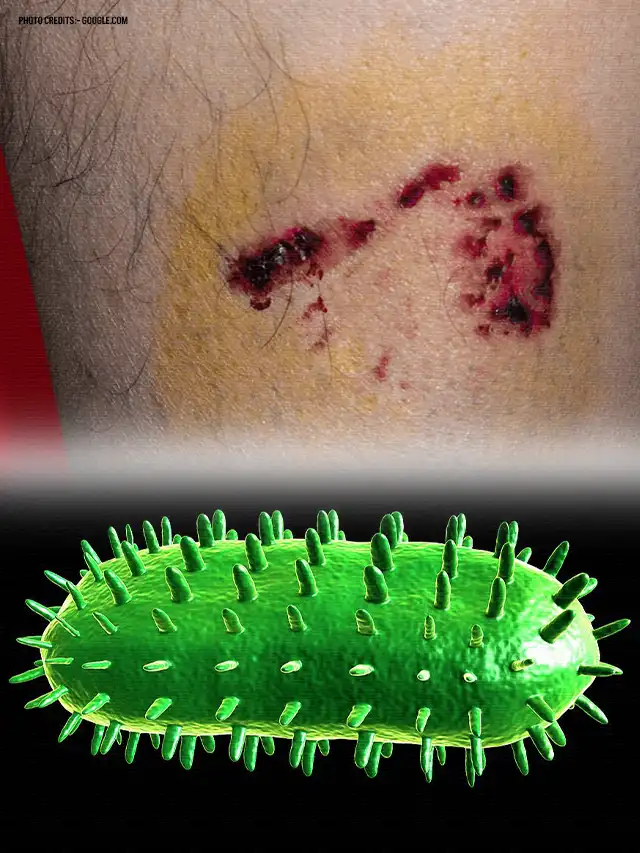
HEALTH BLOG
Rabies Virus Name: Understanding the Silent Killer
-
 Rahul Priydarss
Rahul Priydarss - May 25, 2024
Discover the insidious nature of the rabies virus in our comprehensive guide. From its transmission and symptoms to treatment options and prevention strategies, gain valuable insights into combating this deadly disease. Explore the history, classification, and global impact of rabies, and learn about famous cases that shaped our understanding. Uncover common myths and FAQs while accessing essential information on diagnosis, treatment, and prevention measures. Empower yourself with knowledge to protect yourself and your community from the silent killer.
Introduction of Rabies Virus Name:
The rabies virus, scientifically known as Rabies lyssavirus, is a neurotropic virus that causes rabies in mammals. Rabies is a severe viral infection that primarily affects the central nervous system, leading to neurological complications and, if untreated, death. The virus belongs to the family Rhabdoviridae and the genus Lyssavirus. It is typically transmitted through the saliva of infected animals via bites or scratches. The rabies virus has a characteristic bullet-like shape and comprises a single-stranded RNA genome. It has a global presence, posing a significant health threat in many parts of the world, particularly in areas with high populations of wild and domestic animals that are not vaccinated against the disease.

Table of Contents
What is Rabies:
Rabies, including humans, is a deadly viral disease affecting mammals’ central nervous system. It is caused by the rabies virus, which is usually transmitted through the bite or scratch of an infected animal. The virus is present in the saliva of infected animals and can also spread if saliva comes into contact with mucous membranes or an open wound.
Once the virus enters the body, it travels through the peripheral nerves to the brain, where it causes inflammation and severe neurological symptoms. Early symptoms of rabies in humans include fever, headache, and general weakness or discomfort. As the disease progresses, more specific symptoms appear, such as anxiety, confusion, agitation, hallucinations, hydrophobia (fear of water), and difficulty swallowing. These symptoms are followed by paralysis, coma, and ultimately death if not treated promptly.
The History of the Rabies Virus:
The history of the rabies virus is long and complex, with records of the disease stretching back thousands of years. Here is an overview of its history.
Ancient History:
Circa 2300 BCE: The first known records of rabies date back to ancient Mesopotamia. The Codex of Eshnunna (circa 1930 BCE) mentions rabies and prescribes a fine for dog owners whose animals cause rabies outbreaks.
Ancient Greece: Rabies was known to ancient Greeks. Aristotle (384–322 BCE) described the disease in dogs and noted that it could be transmitted to humans through bites.
Middle Ages:
500-1500 CE: Rabies was prevalent throughout Europe during the Middle Ages. The disease was feared and often associated with superstition and folklore. In some regions, rabid dogs were believed to be possessed by evil spirits.
Modern Era:
18th Century: The connection between animal bites and rabies was better understood. Governments started implementing measures to control the spread of the disease, such as quarantines and culling of stray animals.
19th Century: Major advancements in the understanding of rabies occurred during this time.
- 1885: French scientist Louis Pasteur developed the first successful rabies vaccine. Pasteur and his colleagues used the vaccine to treat a nine-year-old boy who had been bitten by a rabid dog, marking a significant breakthrough in medical science.
- 1886: Pasteur and Émile Roux conducted further research and refined the rabies vaccine, which became widely used for post-exposure prophylaxis.
20th Century to Present:
- 20th Century: Widespread vaccination programs for domestic animals and advancements in rabies diagnosis and treatment significantly reduced the incidence of rabies in many parts of the world.
- In the mid-20th century, many countries implemented mandatory rabies vaccination for pets, leading to a dramatic decline in rabies cases in Europe and North America.
- Efforts to control rabies in wildlife, such as the use of oral rabies vaccines for wild animals, further contributed to the reduction of rabies cases.
- 21st Century: Despite progress in many regions, rabies remains a significant public health issue in parts of Asia and Africa, where access to vaccines and medical care is limited.
- Global health organizations, such as the World Health Organization (WHO), continue to work towards the goal of eliminating rabies through vaccination programs, public education, and improved access to post-exposure prophylaxis.
Classification of the Rabies Virus:
The rabies virus is classified within the broader framework of biological taxonomy. Here is its classification:
Taxonomic Classification:
- Domain: Virus (not a cellular life form, so not classified under the traditional biological domains)
- Realm: Riboviria
- Order: Mononegavirales
- Family: Rhabdoviridae
- Genus: Lyssavirus
- Species: Rabies lyssavirus
The Lyssavirus Genus:
The Lyssavirus genus is part of the family Rhabdoviridae. This genus includes viruses that primarily infect mammals and cause rabies and rabies-like diseases. The name “Lyssavirus” is derived from the Greek word “lyssa,” meaning “rage” or “fury,” reflecting the severe and aggressive symptoms seen in infected animals and humans.
Characteristics of the Lyssavirus genus include:
- Genome: Negative-sense, single-stranded RNA.
- Structure: Bullet-shaped virions.
- Replication: These viruses replicate in the cytoplasm of the host cell and use an RNA-dependent RNA polymerase to transcribe their genome.
- Transmission: Typically transmitted through the saliva of infected animals via bites or scratches.
- Host Range: Primarily infects mammals, including humans, bats, and terrestrial animals.
The Rabies Virus Species:
The Rabies lyssavirus is the species within the Lyssavirus genus that causes rabies, a fatal encephalitic disease. It is the most well-known and studied member of the Lyssavirus genus.
Key features of the Rabies virus species include:
Shape: Characteristic bullet-shaped virions, about 180 nm in length and 75 nm in diameter.
Genome: Single-stranded, negative-sense RNA approximately 12,000 nucleotides long, encoding five proteins: nucleoprotein (N), phosphoprotein (P), matrix protein (M), glycoprotein (G), and RNA-dependent RNA polymerase (L).
Pathogenesis: After entering the host through a bite or scratch, the virus travels along peripheral nerves to the central nervous system (CNS), causing severe neurological symptoms such as anxiety, confusion, paralysis, and hydrophobia (fear of water). If untreated, rabies is almost always fatal.
Transmission: Mainly transmitted through the saliva of infected animals. Common vectors include domestic dogs, bats, raccoons, skunks, and foxes. Human-to-human transmission is extremely rare.
Prevention: Rabies is preventable through vaccination. Post-exposure prophylaxis (PEP), involving immediate wound cleaning and a series of rabies vaccinations, is highly effective if administered promptly after exposure. Vaccination of domestic animals and wildlife management are critical measures to control the spread of rabies.
How Rabies Virus Spreads:
Rabies is a viral disease that spreads primarily through the bite or scratch of an infected animal. Here’s a detailed explanation of how the rabies virus spreads.
Transmission Mechanism:
1- Animal Bites:
Primary Mode: When an animal infected with the rabies virus bites a human or another animal, the virus in the saliva enters the wound. The virus primarily resides in the salivary glands of infected animals, facilitating its transmission through a bite.
Common Carriers: Wild animals like bats, raccoons, skunks, and foxes, as well as domestic animals such as dogs and cats, can carry and transmit the rabies virus.
2- Scratches and Open Wounds:
Secondary Mode: While less common than bites, rabies can also spread through scratches if the infected animal’s saliva comes into contact with the scratch or an open wound on the victim’s skin.
3- Mucous Membranes:
Exposure through Mucous Membranes: Although rare, rabies can enter the body through mucous membranes in the eyes, nose, or mouth if saliva from an infected animal contacts these areas. This can occur through activities like handling or being near an infected animal.
4- Aerosol Transmission:
Highly Uncommon: Rabies transmission through aerosolized virus particles is extremely rare and typically occurs only in specific settings, such as laboratories working with the virus or caves densely populated with infected bats.
5- Organ Transplants:
Very Rare Instances: There have been exceedingly rare cases of rabies transmission through organ transplantation from donors who were unknowingly infected with the virus.
Virus Progression:
1- Incubation Period:
Variable Duration: Following exposure to the virus, there is an incubation period during which the virus replicates within the body before symptoms appear. The length of this period can vary widely, ranging from days to several months, depending on factors such as the location and severity of the exposure.
2- Nervous System Entry:
Travel through Nerves: Once the virus enters the body, it migrates along peripheral nerves towards the central nervous system (CNS), including the brain and spinal cord. This journey through the nervous system is crucial for the virus to establish infection and cause disease.
3- Brain Infection:
Encephalitis: Upon reaching the CNS, the virus infects and replicates within the brain, leading to inflammation (encephalitis). This inflammation is responsible for the neurological symptoms characteristic of rabies, such as confusion, agitation, and paralysis.
4- Spread to Salivary Glands:
Transmission Readiness: As the infection progresses, the virus spreads to the salivary glands, increasing the likelihood of viral shedding in saliva. Infected individuals become highly contagious at this stage, capable of transmitting the virus to others through bites or saliva exposure.
Symptoms of Rabies:
Certainly! Rabies symptoms can be categorized into two main stages: the prodromal stage and the acute neurological stage. Here’s a detailed explanation of each stage.
Prodromal Stage:
1- Initial Symptoms:
Flu-Like Symptoms: The prodromal stage typically begins with non-specific symptoms resembling the flu, including fever, headache, malaise, and fatigue. These symptoms may last for 2 to 10 days.
2- Localized Pain and Tingling:
Pain at the Bite Site: Patients often experience pain, itching, or tingling at the site of the animal bite or scratch where the rabies virus entered the body. This localized discomfort may spread along the nerve pathways.
3- Behavioral Changes:
Anxiety and Agitation: As the virus progresses, individuals may exhibit changes in behavior, such as increased irritability, anxiety, or agitation. They may also become hypersensitive to stimuli, including light and sound.
4- Hydrophobia:
Fear of Water: One of the hallmark symptoms of rabies is hydrophobia, an irrational fear of water. Patients may experience spasms of the throat muscles when attempting to drink, leading to extreme difficulty swallowing liquids.
Acute Neurological Stage:
Hyperactivity and Hallucinations:
- Restlessness and Hyperactivity: As the infection reaches the brain, patients often become increasingly restless and hyperactive. They may exhibit erratic behavior and agitation.
- Visual and Auditory Hallucinations: Delusions, hallucinations, and paranoia may occur, leading to episodes of visual or auditory hallucinations.
Paralysis and Muscle Weakness:
- Progressive Paralysis: Muscle weakness and paralysis typically begin in the muscles closest to the site of the original animal bite or scratch and then spread throughout the body.
- Difficulty Breathing: Paralysis of the respiratory muscles can lead to breathing difficulties and respiratory failure, which is a common cause of death in rabies patients.
Cerebral Dysfunction:
- Confusion and Disorientation: Patients may become disoriented, confused, and unaware of their surroundings as the virus affects cognitive function.
- Seizures and Convulsions: Seizures and convulsions may occur as a result of the virus’s impact on the brain’s electrical activity.
Coma and Death:
- Deterioration of Consciousness: The neurological symptoms worsen rapidly, often leading to a coma as the brain’s function deteriorates.
- Fatal Outcome: Without prompt medical intervention, rabies is almost invariably fatal once symptoms of the acute neurological stage appear, usually within days to weeks of symptom onset.

Diagnosis of Rabies:
Certainly! Diagnosing rabies is a critical process that involves thorough clinical evaluation, laboratory testing, and consideration of exposure history. Here’s a detailed explanation of each aspect of the diagnostic process.
Clinical Evaluation:
Exposure History: Healthcare providers will gather information about any recent encounters with animals, particularly bites, scratches, or exposures to potentially rabid animals. This includes domestic pets as well as wildlife. Travel history to regions where rabies is endemic or recent exposure to animals in such areas is also important to assess.
Symptom Assessment: Neurological symptoms characteristic of rabies, such as hydrophobia (fear of water), aerophobia (fear of drafts or air movement), confusion, hallucinations, and paralysis, are evaluated. The progression of symptoms from initial flu-like prodromal symptoms to neurological deterioration is a significant clinical marker.
Laboratory Tests:
Direct Fluorescent Antibody Test (dFA): This test is considered the gold standard for diagnosing rabies in animals and humans post-mortem. Brain tissue samples, typically from the brainstem, are examined for the presence of rabies virus antigens using fluorescent antibodies.
Reverse Transcription Polymerase Chain Reaction (RT-PCR): RT-PCR can detect viral RNA in various clinical samples, including saliva, cerebrospinal fluid (CSF), and brain tissue. It is particularly useful for diagnosing rabies in living patients and can provide rapid results.
Virus Isolation: Rabies virus can be cultured from clinical specimens, but this method is time-consuming and not commonly used for urgent diagnosis. It involves growing the virus in specialized laboratory conditions.
Post-Mortem Examination:
Histopathological Examination: Brain tissue samples obtained during autopsy are examined under a microscope for characteristic changes. These changes may include neuronal degeneration, inflammation, and the presence of Negri bodies, which are eosinophilic cytoplasmic inclusions in infected neurons.
Clinical Presentation:
Clinical Criteria: The Centers for Disease Control and Prevention (CDC) provides guidelines for diagnosing human rabies based on clinical criteria, including symptoms and exposure history. Diagnosis may be based on a combination of clinical signs and laboratory findings, especially in areas where laboratory testing is limited.
Exclusion of Differential Diagnoses: Other neurological conditions with similar symptoms, such as viral encephalitis, tetanus, or other causes of encephalopathy, must be considered and ruled out through appropriate diagnostic tests.
Treatment Options for Rabies:
Unfortunately, once symptoms of rabies appear, the disease is almost always fatal. However, immediate and thorough medical intervention following exposure to the rabies virus can prevent the onset of symptoms and save lives. Here are the main treatment options for rabies.
Post-Exposure Prophylaxis (PEP):
Wound Care:
Immediate Cleaning: Thoroughly washing and flushing the wound with soap and water for at least 15 minutes can help remove the virus from the site of the bite or scratch.
Disinfection: Applying an antiseptic solution such as povidone-iodine or ethanol to the wound can further reduce the risk of infection.
Rabies Vaccination:
Immediate Administration: Following wound cleaning, rabies vaccination should be administered promptly to individuals who have been potentially exposed to the virus.
Schedule: The standard regimen includes a series of rabies vaccine doses given over a span of several weeks. The vaccine stimulates the immune system to produce antibodies against the rabies virus, protecting against infection.
Pre-Exposure Prophylaxis (PreP):
Vaccination:
Preventive Measures: Individuals at high risk of rabies exposure, such as veterinarians, animal handlers, and travelers to rabies-endemic regions, can receive pre-exposure prophylaxis (PreP) through a series of rabies vaccinations.
Boosters: Regular booster doses may be necessary to maintain immunity, depending on the individual’s level of risk and exposure.
Experimental Treatments:
Milwaukee Protocol:
- Historical Approach: The Milwaukee protocol, an experimental treatment protocol, involves induced coma and antiviral medications in an attempt to slow the progression of rabies in infected individuals.
- Controversial Efficacy: While some cases have shown temporary improvement with this approach, the overall efficacy remains controversial, and it is not considered standard treatment.
Palliative Care:
Symptomatic Management:
Comfort Measures: In cases where rabies symptoms have already developed, supportive care aims to alleviate pain and discomfort.
Sedation: Medications may be administered to manage agitation, anxiety, and seizures.
Respiratory Support: Mechanical ventilation may be necessary to assist breathing in cases of respiratory failure.
Prevention and Vaccination for rabies:
Prevention of rabies primarily involves vaccination, both for individuals at high risk of exposure and for domestic animals. Here’s a detailed explanation.
Human Vaccination:
Pre-Exposure Prophylaxis (PreP):
- Preventive Measure: PreP involves administering rabies vaccine to individuals at high risk of exposure to the rabies virus. This includes veterinarians, animal handlers, travelers to rabies-endemic regions, and laboratory workers.
- Vaccine Schedule: PreP consists of a series of rabies vaccine doses administered over several weeks to stimulate the immune system and establish immunity against the virus.
- Boosters: Periodic booster doses may be necessary to maintain immunity, especially for individuals with ongoing exposure risks.
Post-Exposure Prophylaxis (PEP):
- Emergency Response: PEP is administered to individuals following potential exposure to the rabies virus through bites, scratches, or mucous membrane contact with saliva from a rabid animal.
- Vaccine Administration: PEP involves a series of rabies vaccine doses given over a defined schedule, typically accompanied by rabies immune globulin (RIG) for individuals with higher-risk exposures.
- Effectiveness: When administered promptly and according to recommended guidelines, PEP is highly effective in preventing the onset of rabies symptoms in exposed individuals.
Animal Vaccination:
Domestic Animals:
- Preventive Measure: Vaccination of domestic animals, particularly dogs and cats, is crucial for preventing the transmission of rabies to humans.
- Routine Vaccination: Routine rabies vaccination of pets is recommended by veterinary organizations and public health agencies. Vaccination schedules may vary depending on local regulations and guidelines.
- Public Health Impact: Vaccinating domestic animals helps create a barrier against the spread of rabies within communities and reduces the risk of human exposure to the virus.
Wildlife Vaccination:
- Targeted Efforts: In regions where wildlife populations serve as reservoirs for rabies, targeted vaccination campaigns may be conducted to control the spread of the virus.
- Oral Rabies Vaccination (ORV): ORV involves distributing vaccine-laden baits in wildlife habitats to immunize target species such as raccoons, foxes, and coyotes.
- Ecosystem Approach: Wildlife vaccination programs contribute to overall rabies control efforts by reducing the prevalence of the virus in animal populations and minimizing the risk of spillover to humans and domestic animals.
Global Impact of Rabies:
Rabies has a devastating global impact, despite being a preventable disease. Here’s a breakdown of its key effects.
Human Deaths: Rabies is estimated to cause around 59,000 deaths annually worldwide [WHO Rabies]. This number might be an underestimate, and tragically, 40% of these deaths are children under 15 [WHO Rabies].
Geographic Disparity: Over 95% of rabies deaths occur in Africa and Asia [WHO Rabies]. This disproportionately affects poorer, rural communities with limited access to healthcare and veterinary services.
Economic Burden: The global cost of rabies is estimated at a staggering US$8.6 billion per year [WHO Rabies]. This includes healthcare expenses, lost income due to deaths, and costs associated with dog vaccinations.
Animal Suffering: Dogs are the main source of rabies transmission to humans. Millions of dogs suffer and die from rabies itself, and also due to culling measures driven by fear of the disease [Global Alliance for Rabies Control].
Rabies in Animals:
Rabies is a viral disease that affects mammals, including humans and both domestic and wild animals. Here’s a breakdown of rabies in these two categories:
Domestic Animals: Domestic animals such as dogs, cats, and livestock are susceptible to rabies if bitten by an infected animal. Here are some key points regarding rabies in domestic animals:
Transmission Risk: Domestic animals can contract rabies through bites from rabid wild animals or exposure to the saliva of infected animals. Unvaccinated pets are particularly vulnerable to contracting rabies and may pose a risk of transmission to humans.
Clinical Signs: Rabies in domestic animals often presents with behavioral changes such as aggression, restlessness, and unusual vocalizations. Neurological symptoms including incoordination, seizures, and paralysis may also occur as the disease progresses.
Prevention: Vaccination is the most effective way to prevent rabies in domestic animals. Regular vaccination of pets helps protect them from the virus and reduces the risk of transmission to humans. Responsible pet ownership, including keeping pets indoors or supervised when outdoors, can also minimize the risk of exposure to rabid wildlife.
Wild Animals: Certain wildlife species serve as reservoir hosts for the rabies virus, maintaining its presence in the environment. Here’s what you need to know about rabies in wild animals:
Reservoir Hosts: Wild animals such as raccoons, skunks, bats, foxes, and coyotes are common reservoir hosts for rabies. These animals can spread the virus to other wildlife, domestic animals, and humans through bites or scratches.
Clinical Signs: Rabies in wild animals may manifest similarly to domestic animals, with behavioral changes such as aggression, disorientation, and abnormal vocalizations. Neurological symptoms, including paralysis and difficulty walking, may also be observed.
Control Measures: Control of rabies in wildlife populations often involves targeted vaccination campaigns aimed at reducing the prevalence of the virus. Habitat management, public education, and surveillance efforts are also important for managing rabies in wild animal populations and preventing spillover to humans and domestic animals.
Trending Myths of Rabies:
Rabies is often surrounded by myths and misconceptions that can lead to unnecessary fear and misinformation. Here are some common myths associated with rabies.
Only Dogs Carry Rabies: While dogs are a significant reservoir for rabies in many parts of the world, other animals such as bats, raccoons, skunks, and foxes can also carry the virus. Any mammal can potentially contract and transmit rabies, so it’s essential to be cautious around all animals, not just dogs.
Animals with Rabies Always Look Aggressive: While aggression can be a symptom of rabies in animals, not all rabid animals display aggressive behavior. Some may appear unusually tame or lethargic, while others may exhibit neurological symptoms such as paralysis or difficulty walking. It’s essential to recognize a range of symptoms when assessing the risk of rabies.
Rabies Can Be Cured by Home Remedies: Rabies is almost always fatal once symptoms appear, and there is no cure for the disease. While prompt medical treatment following exposure can prevent the onset of symptoms through post-exposure prophylaxis (PEP), once symptoms develop, the disease is invariably fatal.
Rabies Can Be Transmitted through Saliva Alone: While rabies is primarily transmitted through the saliva of an infected animal, simple contact with saliva, such as petting an infected animal, is not typically sufficient to transmit the virus. Transmission usually occurs through bites or scratches that break the skin and allow the virus to enter the body.
Animals with Rabies Always Foam at the Mouth: While foaming at the mouth is a classic image associated with rabies, not all rabid animals exhibit this symptom. Foaming may occur due to difficulty swallowing, leading to excess saliva production, but it is not a definitive sign of rabies.
Rabies Only Affects Animals, Not Humans: Rabies is a zoonotic disease, meaning it can be transmitted from animals to humans. Humans can contract rabies through bites, scratches, or exposure to the saliva of infected animals. Without prompt medical treatment following exposure, rabies in humans is almost always fatal.
Rabies is Not a Concern in Developed Countries: While rabies is less common in developed countries with robust vaccination and animal control programs, it is still a significant public health concern globally. Travelers to rabies-endemic regions should be aware of the risk and take precautions to prevent exposure.
Famous Cases of Rabies:
Several notable cases of rabies have garnered attention over the years due to their impact on public health, medical understanding, and even popular culture. Here are a few famous cases.
The Case of Jeanna Giese (2004): Jeanna Giese, a teenager from Wisconsin, USA, survived rabies without receiving the typical post-exposure prophylaxis (PEP) treatment. She was bitten by a bat but did not seek medical attention until symptoms appeared. Her case led to the development of the “Milwaukee Protocol,” an experimental treatment protocol for rabies.
The Death of Joseph Meister (1885): Joseph Meister was the first person to receive the rabies vaccine developed by Louis Pasteur. Meister, a 9-year-old boy, was bitten by a rabid dog in France. Pasteur administered his experimental vaccine, which ultimately saved Meister’s life and laid the foundation for modern rabies prevention and treatment.
The Death of Dr. Rodney Willoughby (2018): Dr. Rodney Willoughby was a pediatric infectious disease specialist who treated Jeanna Giese and played a key role in her recovery. Despite his efforts to develop a standardized treatment protocol based on the Milwaukee Protocol, Willoughby tragically died from complications of lymphoma in 2018.
The Death of Cujo (1981): In Stephen King’s novel “Cujo” and the subsequent film adaptation, a friendly Saint Bernard dog named Cujo becomes rabid after being bitten by a bat. The story follows Cujo’s transformation into a vicious killer and the terror he inflicts on a small town. While fictional, Cujo’s story has contributed to public perceptions of rabies.
The Rabies Outbreak in Bali (2008): In 2008, an outbreak of rabies occurred on the Indonesian island of Bali, resulting in numerous deaths and widespread fear. The government implemented mass vaccination campaigns for both humans and animals to control the outbreak and prevent further transmission of the virus.
FAQs about Rabies Virus:
A1: Unfortunately, once rabies symptoms appear, it is almost always fatal. Immediate post-exposure treatment is essential to prevent the disease.
A2: Yes, there are vaccines available for both humans and animals to prevent rabies.
A3: Avoid contact with wild animals, vaccinate pets, and seek medical attention immediately if bitten by an animal.
A4: Dogs, bats, raccoons, skunks, and foxes are common carriers of the rabies virus.
A5: Wash the wound thoroughly with soap and water, and seek immediate medical attention for potential post-exposure prophylaxis.

-Please remember, to always consult with healthcare professionals or Doctors for personalised advice related to medical conditions.
Conclusion:
Understanding the rabies virus is essential to combat this deadly disease. From transmission to treatment, awareness and prevention are paramount. With continued education and vaccination efforts, we can work towards eliminating rabies globally. Let’s dispel myths, raise awareness, and prioritize public health to save lives. Together, we can create a world where rabies is no longer a threat.




